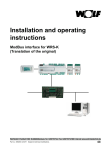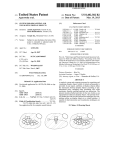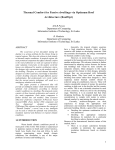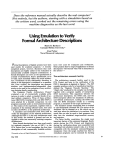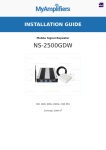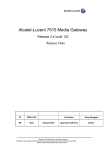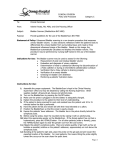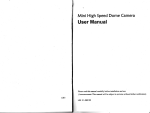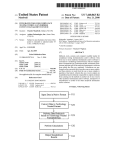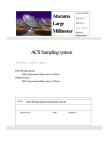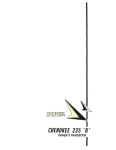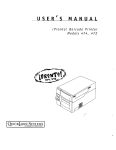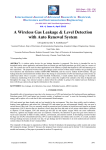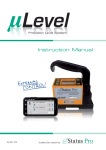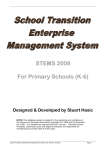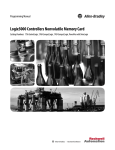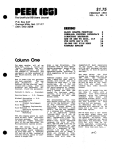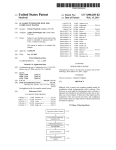Download Graphical user interface system for steam turbine operating conditions
Transcript
USOO5838588A Ulllted States Patent [19] [11] Patent Number: Sant0s0 et al. [45] [54] GRAPHICAL USER INTERFACE SYSTEM FOR STEAM TURBINE OPERATING Date of Patent: Nov. 17, 1998 5,479,358 12/1995 Shimoda et al. ...................... .. 364/492 5,640,176 6/1997 Mundt et al. ......................... .. 345/146 CONDITIONS [75] 5,838,588 FOREIGN PATENT DOCUMENTS Inventors: Nugroho IWan Santoso, Cranbury, 0 389 132 of 0000 N.J.; Walter Zorner, Baiersdorf, Germany European Pat. Off. . OTHER PUBLICATIONS Patent Abstracts of Japan, vol. 004, No. 072 (M—013), 27 [73] Assignee: Siemens Corporate Research, Inc., Princeton, NJ[21] May 1980 & JP 55 035112 (Toshiba) “Comparing Display Integration Strategies for Control of a Simple Steam Plant”, Edlund et al., 2 Oct. 1994, Proceed ings of the Int’l Conference on Systems, Man and Cyber Appl. No.: 768,047 _ [22] Flled: netics, San Antonio, pp. 2686—2691. Dec‘ 13’ 1996 Omega Engineering Inc., The Data Acquisition Systems, [51] Int. Cl.6 ................................................... .. G05B 15/00 vol- 29,11 B—1 to b—18, 1995-_ [52] US. Cl. .............................. .. 304/528.22; 364/468.03, “Turbme Back Pressure Idenn?canon And OPtlmlZatlOn 36 4/46801; 36 452825 With Learning Neural Networks”, Mathur et al. Advances in [58] Field Of Search ............................. .. 364/557, 468.03, Instrumentation And Control’ VOL 45’ NO' Pa“ 01’ 1 Jan' 364/46804, 468.01, 528.22, 528.25; 345/145, 146, 340, 428, 915, 919, 920, 921, 970, _ _ _ _ 1990’ PP' 229_236~ Primary Examiner—Louis M. Arana 339 Assistant Examiner—Hien Vo Attorney, Agent, or Firm—Adel A. Ahmed [56] References Cited [57] ABSTRACT U.S. PATENT DOCUMENTS _ 3,873,817 A graphical user interface provides a real-time information 3/1975 Llang .................................... .. 364/492 display for a Supervising engineer in Charge of turbine 4,576,007 272932; 8128881111; 3/1986 Arakawa 61 al................... ....................... .;;-.23;;a7121 .. 60/660 C°mb1na_“9nS so of Operatmg Commons are readlly_obser‘_’ed 476797399 7/1987 477647025 8/1988 Jensen _____ __ Smolder _ _ _ _ _ _ _ _ 4,827,429 5/1989 silvestri, Jr, 4,891,948 1/1990 Kure-Jensen et al. 4,970,670 11/1990 Twerdochlib 572677435 12/1993 Frenkel et al 573057230 4/1994 Matsumoto et a1‘ 5’333’240 7/1994 Matsumoto et i'?j'" _ _ _ _ __ 60/646 and deviations are made apparent so'that correctlve actlon 374/144 can be lnltlated rapldly. An overvleW of the operatlng 364/494 60/645 364/571-03 60/204 364/495 situation is made more readily apparent by representing the operating expansion and compression processes by lines on a Mollier enthalpy/entropy chart. In combination, real-time parameter values and parameter trends are also presented. Using the Mollier chart information in conjunction With 395/23 can more qulckly ldentlfy and correct undeslrable and 5:161; trend and real-time ‘information, the supervising engineer 5,353,628 10/1994 Bellows .......... .. 73/2501 5,386,689 2/1995 BoZich et al. 5,439,160 8/1995 Marcantonio ......................... .. 228/102 Potentially troublesome Operation Conditions .. 60/39.33 ACRUISIIIUN LEVEL 8 Claims, 14 Drawing Sheets MEASURED SIGNALS I l l l SIMAIIC 55 l I CUMMUNICAIIDN LEVEL ‘ EIHERNEI DMNI~SERVER, REC/let PHASE V ADMINISIRAIIVE LEVEL IELEGRAN DISIRIBUIUR TIME’ CONTROL DELUG IELEGRAR RECEIVER RRTS RERUIREMENI IELEBRAR WATCH DOG RDIS RAN DATA TELEBRAM ACTION PRUDESS DDNIRUL MANAGER i F " *"n. 'i" 7 F TRAINING ‘ Lung/110m P“? ESTIMATOR 1 RESULT PARAMETERS bid DATA SCHEME ; L "i113 FITTED‘ ‘FREE’? DATA 2"‘? MODEL 1 RA N N6 1 5 1 RA R MA % m .ELEVEL PRESENTATION 1 ‘—‘ l ] FREE GRAPHICS RINDABE GUI A I L ...... "3 SHARED MENURV U.S. Patent Nov. 17,1998 Sheet 2 0f 14 5,838,588 FIG. 2A !____________________________ i Pms—+O Tms—+O LAYER (3] INPUT CONNECTIONS I OUTPUT CONNECTIONS O-T-v-Tblads OF HIDDEN UNITS FIG. 2B 3 .L E.CMA_ _ _ NP _ _PC _ C _N .I.NPD.mB. 5SX 1w 1r.--I 0 A. tDm_ !\ SN m_ mH ETIU _IN _TI _?u NE UT _ S E1UV. OMD_NHE0ID_ C ML_ C MA_N H0E'UL0N TCTl-I WIMN“ __ UATEL PT10 _ _ ITi3l]:1. .D 1 AU MCAALTICHUELMAATTI IOMNL2 Tl~ a E _ m 1 |_ _l .I n 0 U.S. Patent Nov. 17,1998 Sheet 3 0f 14 FI G . 3 HATER/STEAM CYCLE EXPEBEENTAL ANALYSIS PROGRAM: GENERATE DATA / COMBINE DATA I REFDRMAT AND ORGA NIZE TRAINING AND TESTING DATAFILE I ANN MODULE TRAINING AND VALIDATIDN MDDIFY TRAINING ANN STRUCTURE PARAMETERS OR THE CONVERSE 9 SATISFACTORILY. I ANN MDDULE TESTING SATISFACTORY? 5,838,588 U.S. Patent Nov. 17,1998 Sheet 4 0f 14 5,838,588 FIG. 4A MAIN MENU FRONT PAGE MOLLIER TREND TURBINE IMAGE SHARED MEMORY MANAGEMENT FREE GRAPHICS L """" "I """" "J I SHARED MEMORY DATA SERVER DATA BASE FIG. 4B FRONT PAGE HP PARAMETER LABELS LP1 LP2 HP DRAWING ROUTINE T SIMILAR STRUCTURE FOR LP1, LP2, . . . ~-—+ ----------------------------- !i_________________.__________________________-_____ GLOBAL LABELS SHARED MEMORY MANAGEMENT} U.S. Patent Nov. 17,1998 Sheet 5 0f 14 5,838,588 FI 6 . 4C MOLLIER DIAGRAM HP LPI LRRNT' /\ MDLLIER GRAPH SIMILAR STRUCTURE A FDR LPI, LPE, . . . PARAMETER LABELS BACKGROUND ROUTINE DATA DRAWING l ROUTINE !L.__._.___._..______________________.__.__________.___.__. GLOBAL LABELS GRAPH DATA SHARED MEMDRY MANAGEMENTJ! | FIG. 40 TREND DIAGRAM HP LPA PARAMETER LABELS LP2 TREND GRAPH /\ DATA T_ _ _ _ _ _ _ _ _ i GLOBAL LABELS - _ _ _ _ __ I‘ SIMILAR STRUCTURE FDR LPI, LP2, . . . DRAWING ROUTINE ._.—.....__-___._____—.__.—___________.lI GRAPH DATA i SHARED MEMORY MANAGEMENT : |_ ____________________________________ ___1 U.S. Patent H5 $2 NH “8 Mom 2.; 2 @53m20:2 m5 mEI SZ #31:GE ; mzE m 5m5 :25 Nov. 17,1998 Sheet 6 0f 14 5,838,588 U.S. Patent Nov. 17,1998 Sheet 8 0f 14 FIG. 50 Pin=410.30bar Peh=160.58r‘p||| Teh 403.06bar 5,838,588 U.S. Patent 5EFIG. Nov. 17,1998 Sheet 9 0f 14 5,838,588 U.S. Patent H¢¢ UMQ m“ we 00 @@ mam“ Nov. 17,1998 Sheet 14 0f 14 5,838,588 m1op4Hzmc wofp3&2mamE_8&208ogm1.w0za2%é @mz: ..802 mg? m 5% a: we: Hi mzH mnH £25m.Wo0Os2? n..os as" .02 ‘02 ‘[02 “o2 .52 H02 womm" .lomm m 1% “am0 .ém g isan 8%E $2..0%-3‘-5‘0%. ©“Ham OHam “ “am 5% O “8m “ 6%“OW02 .103 .52 “2m “am ém “ M w E z a Q Z s E @ w “ 5 e ém 5% Ham 1 ; n~05~03MOEHOEEO é“_5am .532u5:we:We:5&2 0was?as-02_ m ‘.3 .2 é é"é“a “a " .lcw wow " mom _ 4 325E5a: 5,838,588 1 2 GRAPHICAL USER INTERFACE SYSTEM FOR STEAM TURBINE OPERATING CONDITIONS In a accordance With another aspect of the invention, a hybrid approach, 5 measured values are utiliZed. Asubset of, for example, 4 parameter values is used for training the ANN and another subset of, for example, 3 values is used for performing a calculation for another intermediate parameter. Using the intermediate parameter and one of the 5 measured values, a blade temperature is calculated. In accordance With still another aspect of the invention, In the operation of steam turbines, as for turbo generators, it is important that operating parameters be kept Within de?ned limits for proper and safe operation, includ ing start-up and shut-doWn phases. Unsafe operation can have grave consequences for personal injury and material damage. the user interface provides a real-time information display 10 Reference is hereby made to an application by the present inventors being ?led concurrently hereWith and for a supervising engineer in charge of turbine operation so that critical parameter values and undesirable combinations of operating conditions are readily observed and deviations entitledAMETHOD FOR BLADE TEMPERATURE ESTI are made apparent so that corrective action can be initiated MATION IN A STEAM TURBINE (Ser. No. 08/764,381) rapidly. While graph plots of parameters can be readily presented, such a format generally does not readily provide Whereof the disclosure is incorporated herein to the extent it does not con?ict With the present application. 15 an overall picture of the state of the turbine With regard to the distribution and combination of temperature, pressure, Typically, in steam turbo-generator operations, the tur bine Was operated around full poWer or, When the demand for poWer Was insuf?cient, it Was shut doWn. Particularly in steam Wetness or superheat, and turbulence effects. operation as part of a large poWer grid, operation at less than full load may be required. Under such conditions, complex patterns of temperature, pressure, steam Wetness, reheating, the operating situation is made more readily apparent by expansion and compression, may occur, possibly resulting in combination, real-time parameter values and parameter In accordance With the present invention, an overvieW of representing the operating expansion and compression pro cesses by lines on a Mollier enthalpy/entropy chart. In excessive turbine blade temperature. Such conditions may spell blade failure With possibly disastrous consequences. Thus, monitoring operation under conditions Where the 25 trends are also presented. Using the Mollier chart informa tion in conjunction With trend and real-time information, the supervising engineer can more quickly identify and correct intake steam pressure is at or loWer than the output pressure undesirable and potentially troublesome operation condi are of practical importance. Background material is avail tions. In accordance With an aspect of the present invention, a able in books such as W. W. Bathie, “Fundamentals of gas turbines”, John Wiley and Sons, 1996; and H. Herlock, “Axial ?oW turbines: Fluid mechanics and system utiliZes a hybrid ANN (arti?cial neural network) algorithmic based scheme for estimating the blade tempera thermodynamics”, ButterWorth, London, 1960. ture from other measurements Which are commonly avail Good mathematical models for simulating the steam able. The commonly available measurement values are herein utiliZed. The training data for the ANN includes both behavior in a turbine in its entire operating domain are not readily available, especially concerning periods in Which the 35 ing detailed description in conjunction With the draWing, in pressure. During such periods, the ?uid ?oW behavior is very complex because the radial component of velocity become signi?cant as compared With the axial velocity component. The available simpli?ed mathematical models for simulating the steam behavior during normal loading typically do not perform properly When the intake pressure Which FIG. 1 shoWs a Windage module architecture in accor dance With the invention; FIG. 2 shoWs an arti?cial neural netWork based scheme for blade temperature estimation in accordance With the invention; is near or loWer than the output pressure. In neW large steam turbines, temperature measuring devices are installed at the respective stages of the HP and LP casings. These measurements provides an indication to 45 applicable in conjunction With the invention; and FIG. 5a to 5j shoWs graphical interface vieWs applicable blade temperature exceeds its limit. The need for blade temperature monitoring for smaller and older turbine, as in conjunction With the invention. During the operation of the steam turbine, heating due to Windage must be maintained Within alloWable limits by the operating mode. The Windage modules for HP and LP turbines in accordance With the present invention Will pro Well as a more practical and cost effective Ways than installing temperature probes, has led to a need, herein recogniZed, for a practical system for estimating in real time and monitoring turbine blade temperature during operation. 55 In accordance With an aspect of the invention, a method for blade temperature estimation in a steam turbine utiliZes deduced from the estimation and other available measure ment values. input and output stages. Initially, blade temperature is simu In the folloWing, examples of the Windage phenomenon lated by using a Water/steam cycle analysis program as Well as by directed experiments. An arti?cial neural netWork (ANN) is trained by presenting the measurement values and the blade temp values. In a present exemplary embodiment, method the ANN is used directly to derive operating blade temp values. vide the operator With an estimation of the blade temperature at the respective turbine stages. The interactive user inter face herein disclosed displays the real-time value, a trend graph of these values, and the respective states Within the Mollier diagram. Supervisory recommendation may be measurement values including pressure and temperature at locations other than directly at the blades, principally at the it is found that 4 values provide a satisfactory result. In one FIG. 3 shoWs a training procedure for an arti?cial neural netWork in accordance With the invention; FIG. 4a to 4a' shows graphical user interface structures the operator or supervising engineer in charge Whenever the The present invention is intended to be practiced prefer rably With the application of a programmable computer. data generated by mathematical model and by experiment. The invention Will be better understood from the folloW main-steam pressure is near or loWer than the exhaust are given. In the HP turbine, as there is no steam ?oW 65 through the turbine folloWing a trip, the extent of energy transfer depends on the pressure and the steam density in the turbine. At a full load trip, the corresponding high cold reheater pressure Will initially be present. In order to avoid impermissible heating by Windage losses, an adequate pres 5,838,588 4 3 managing the buffer capacity (de-log), 16, self check ing process (Watch-dog), 18, and several timers/clocks for interrupt purposes (time-control), 20. Self checking sure decay or a certain cooling steam How is required. The expansion lines in the Mollier diagram indicate the advan tage of a sufficient HP turbine ?oW after full load rejection to Zero load. The operator is much better informed by such a ?gure. process is mainly to check the status of all processes Within the system, and re-boot the system if necessary. 4. Action level. The action level controls the continuous On-line visualization of the expansion/compression lines is especially bene?cial for other parts of the turbine Which are subject to overheating, due, in the present particular case, to the Windage phenomenon. For heating steam turbines When the control valves, for example, in the cross over line for the tWo loWer heaters are closed, the LP turbine requires background process and computation. These include the initiation of data request (sending RQTs), manage 10 description of this level can be found in the next section. This level may also include the output man cooling steam to hold Within permissible limits the tempera ture rise caused by Windage in the last stage. In this operating mode, the steam in the LP turbine absorbs energy resulting from the Windage losses Which predominate sig ni?cantly Within the last stages. In general the Windage module Will folloW the system ment of incoming data (RDTs), data storage, all com putation processes, and storage of results. Amore detail agement Which test the validity of the computation result. In this scheme the results of the hybrid arti?cial 15 neural netWork (ANN) estimator are alWays compared to the result of the analytical module. This veri?cation is required to detect possible bad results Which are usually caused by input values Which are far aWay from architecture used in a system knoWn as the DIGEST system. DIGEST is a modular monitoring system for poWer system all samples that had been presented during the ANN plant developed by the KWU-FTP activity of Siemens Aktiengesellschaft, (Simens AG), a corporation of Germany. training period. Large discrepancies may indicate that further re-training is in order. DIGEST features a modular system architecture Which can be divided into six different levels Which Will be explain brie?y beloW. The module components are Written in C, With much ?exibility in building any structure of choice. The proposed Windage module system architecture is 5. Data level. The data level handles all processes con cerning data storage and access. It includes the data server 22 and data base 24. All access to the data base 25 shoWn in FIG. 1. The ?rst tWo levels are already available be accessed easily by all levels. as part of DIGEST. Modi?cations Were done to the admin istrative and data levels. Modi?cations in both the commu nication and data levels include parameter speci?cation Which is needed for requesting the module-speci?c data through the data bus,and for creating the data server and data base. The main Windage module development is done mainly at the action and presentation levels. As indicated in FIG. 1, the six levels in the Windage must be done through the data server 22. Once the data is stored in the right format into the database 24, it can 6. Presentation level. The presentation level provides a graphical user interface Which alloW the users to vieW all the necessary information in several different fashions, that is, current values, trend diagram and Mollier diagram. It consist of the Windage Graphical User Inteface 26, Free Graphics 28, and shared memory 30 for storing the intermediate parameter values needed 35 module are: for the user interface. The free graphics is an indepen dent graphical tool for plotting any parameter values 1. Acquisition level. This level manages the data acqui sition process, Which comoprises several program mable logic controllers (PLC) 2 of the type Siemens of the original DIGEST system. The information is presented in several layers starting stored in the data base. This tool is developed as a part Simatic 5. Documentation on Simatic 5 is available With the main Windage screen Which Will mainly shoW the from Siemens Industrial Automation. Its capabilities blade temperatures. The subsequent layers Will shoW the include signal sampling, A/D conversion, limited computation, executing sequence process action, cycle provide information on all parameter values Which are timing, and open communication functions. It is used in relevant to the operator for making appropriate decisions detail conditions for each turbine section. These layers Will this context as a data acquisition device Where it 45 concerning the turbine operation. Further detail on the samples the measurement data at a predetermined rate, process Within this level is provided in the folloWing sec tions. detail in the next section. A development screen is optionally provided for accessing some internal module and digitiZes it and transfers the data through the ethernet netWork asynchronously. 2. Communication level. This level basically is the com munication server 6 Which manages the transfer of system parameters or processes; hoWever, principally because of security reasons, this feature may preferrably be information betWeen the netWork and the DEC (Digital omitted in an actual Working version. The monitoring process may not alWays be necessary to cycle at the same rate at all times; it should depend on the turbine operating conditions. Several scenarios can be pre Equipment Corporation) digital Workstation machine (s). The standard DEC module that handles the com munication issue is called Omni-Server/DECnet PhaseV. The processes Within the DEC Which manage the the data transfer are indicated by DEC-S5, 8, and S5-DEC, 10. DEC-S5 manages the data transfer from the adminstrative level to the S5, and S5-DEC manages data transfer from the S5 to the adminstrative level. 3. Adimistration level. An administration level of control handles the data request from the Windage process control by propagating the request in the right format to a communication level, Which is done by a telegram distributor module 12. It also manages the incoming 55 determined for each speci?c turbine. For example, no load, full load, and loW load during sloW shutdoWn, start-up, and load rejection. The monitoring cycle should be adjusted automatically for different conditions, depending on their criticalities, and the respective display may be arranged to pop-up to assist the operator. The Windage module basically has tWo main processes, the background process and the interactive display process. The background process is responsible for obtaining the necessary parameter values, calculating the blade tempera data in a certain format and forWards the data back to 65 ture at a prede?ne rate, and recording the relevant informa the process control for storage. This is done by a telegram receiver module 14. Other functions include tion into the appropriate shared memory and data base. The interactive display process Will shoW the necessary or 5,838,588 5 6 requested information graphically at any point of time. The One approach directly estimates the blade temperature using a straightforWard 3 layer ANN, FIG. 2 (a). The second approach uses a hybrid technique, FIG. 2(b) by decompo process rate is limited by the minimum amount of time required before all measurements stabilize, and Will vary based on the severity of the turbine condition. Operation near the critical blade temperature may require faster pro sition of the intermediate parameters, Where: a. One intermediate parameter is calculated analyti cally using cess rate. Before the monitoring process, the ANN must be trained. The training sub-structure is responsible for producing the appropriate Weights and parameters that Will be used in the Tms monitoring module. This process is done off-line and is not controllable through the GUI interface. The netWork is Pm. Where n0 is a given constant related to a speci?c turbine siZe. from ?eld experiments. The experiments concentrate on generating data in speci?c loW steam ?oW conditions, such as shutdoWns, loss of loads, and start-ups. This arrangement b. Another intermediate constant (n) Will be calculated by the trained ANN based on the current input values. c. Using the tWo intermediate values, the current blade is expected to be able to estimate the blade temperature for the entire turbine operating ranges. Minimal inputs to the temperature is then calculated using the equation Equa estimator are the real-time measurement values of the pres 20 tion 2 beloW. inputs can be optionally provided and evaluated. The background process Will obtain measurement data, calculate the blade temperature and other necessary values, T3 Tblude = Eqn. 2 nil P3 Pex and store those values in appropriate locations. The process sequences are as folloWs: In this manner, a separation is maintained betWeen the Request the necessary measurement data to Acquisition (mathematically) unknoWn model from the knoWn model. In this manner, the complexity and nonlinearity Within the “black box” ANN model is reduced. Moveover, this also helps in reducing the ANN model dependence on speci?c turbine parameters. This improves the accuracy and robust ness of the overall estimation scheme, including generali Level through the Communication (using DEC-S5 protocol) and Administrative Levels (telegram distributor). Receive measurement data from data acquisition system Simatic 5 (Siemens PLC). The request is propagated through the ethernet netWork, communicated using the SS-DEC protocol, and managed by the tele-capture Within the admistrative level. The list of the measure ment parameters include: "0 P3 trained using the simulated data obtained by computing the estimated temperature using the analytical means for the expected normal operating domain, and actual data obtain sure of the main steam, temperature of the main steam, pressure of the third stage and exhaust pressure. Additional Eqn. 1 ngil 35 Zation betWeen different turbines. This alloWs the method to retain ?exibility such as in the alteration of intermediate parameters in the light of neW knowledge, Which also applies to input parameters. Such adaptability is herein Pms=Pressure of main steam (bar), contemplated. Tms=Temperature of main steam (°C.), P1=Steam pressure before blading (bar), The blade temperature estimation and other measurement parameters are then stored in tWo different places: the Data Base and intermediate Shared Memory. T1=Steam temperature before blading (°C.), a. All values are stored in the Data Base through the Data Server b. Values needed for display Within the GUI are also P3=Pressure at the third stage Pex=Exhaust pressure after reheater (bar) Peh=Exhaust pressure before reheater (bar), Teh=Exhaust temperature before reheater (°C.), 45 Tcb=Bottom casing temperature (°C.), process. FIG. 3 shoWs the general traning process Which appli Tcu=Upper casing temperature (°C.), cable to the ANN-module either in the direct approach or the Tci=Inside casing temperature (°C.), Tco=Outside casing temperature (°C.), N=Rotational speed (RPM) Pout=Output poWer Preprocess incoming data into the desired format (interpreter). This process basically reads the incoming data hybrid approach. The only difference is in the input parameters as indicated in the background process. The process can be described as folloWs: The ?rst step is data construction Which basically com bines the data obtained from simulation using Water/steam 55 string and reformat it to a standard ASCII format. Store data in the intermediate ?les for futher processing. The estimator Will calculate the blade temperature value using the measurement values. The input measurment values used for estimating the blade temperature, at least for the HP 4. Exhaust pressure (Pex). 5. Rotational speed. cycle analysis and data obtained from the experiments. Such analysis is for example included in thermodynamics mod ules Within the DIGEST system. The Water/steam cycle analysis is used inside the themodynamic module in the DIGEST system. As has been explained, the DIGEST moni toring system is currently available in the market through SIEMENS AG. turbine, are: 1. Pressure of the main steam (Pms), 2. Temperture of the main steam (Tms), 3. Pressure at the third stage (P3rd), and stored in a temporary Shared Memory. These values are then available for reading by the GUI 65 Next, the data is re-formatted such it matches the input format of the ANN. The data is then reorganiZed by sepa rating the data into tWo separate data ?les Where one is used for training and validation purposes, and one for testing purposes. Although there is no certain rule for regrouping the available data, data should be reorganiZed such that all 5,838,588 8 7 operating regions should be Well represented. In accordance With the present exemplary embodiment, 80% of the avail or any other turbines (of applicable). For each turbine, there are three vieW WindoWs that can be selected through the ‘DIAGRAM’ menu: able data is utilized for training and validation and the rest for testing. The ANN structure is a standard multilayer, With 1 hidden layer. The number of hidden units may vary from 4 to 10 turbine overvieW (FIGS. 5(b)—5(a), mollier diagram (FIGS. 5(e)—5(g), or Without signi?cant improvement in performance: a longer traning period is needed for larger number of hidden units, trend diagram WindoW (FIGS. 5(h)—5(]'). The ‘turbine overvieW WindoW’ gives the current value of and it may run the risk of over?tting. In reference to FIG. 3, starting With an initial set of traning parameters, including type of optimiZation algorithm, type 10 of activation function, number of hidden units, error thresholds, the training process is started. The optimiZation algorithm used is a standard technique available in various optimiZation or Neural Network textbooks. See, for example, HertZ, A. Krogh, and R. G. Palmer, “Introduction grid. For example, such a routine is available from Siemens AG in VISUM, a user manual, Version 3, October 1992. 1991; and D. Rumelhart, J. L. McClelland, and the PDP Several features Which built into the Mollier diagram WindoW include: 1. Capability to Zoom Within the enthalpy-entropy graph Reseach Group, “Parallel distributed processing: Explora tion in the mocrostructure of cognition, Volume 1: Foundations”, MIT Press, Cambridge 1987. Several techniques Were investigated in conjunction With just by creating a box With the mouse enclosing the the present exemplary embodiment, including gradient desired region. 25 vergence is obtained by applying the one variation of If the system satisfactorily converges such that the vali the vieWing parameters to the user preferences. It also provide temperature thresholding Which alloW the user dation error thresholds are satis?ed then the ANN param 35 increase the possibility ?nding the global optimal solution The solutions are then tested using the data test ?le. The solution With the smallest error Will be used in the estimation process during the background processl. Will give the user access to the complete data base. This component is provided Within the DIGEST system. The GUI display process Will access the necessary data 45 diagram, or a total heat/entropy diagram, serves as a familier from the Shared Memory, With the exception of the FREE GRAPHICS routines Which Will access data from the data base through the data server. While the invention has been described by Way of exem environment for any thermodynamics engineer and a better representation of the turbine condition With respect to all knoWn critical operating boundaries. Therefore, this on-line plary embodiments, various changes and modi?cations Will turbine condition visualiZation Will better help a user in suggest themselves to one skilled in the art Who becomes taking appropriate control actions. familiar With the invention. For example, the choice of Generally the GUI process must be initiated by the user. It Will access values stored by the background process as parameters made herein can be changed as a matter of choice or convenience. These, and like changes are contemplated to be Within the scope and spirit of the invention Which is 55 The Windage Graphical User Interface Module can be initiated independently or from Within DIGEST. This Will automatically initiate the connection to the Shared Memory unit. The shared memory unit is basically a routine Which de?ned by the claims folloWing. What is claimed is: 1. In a system for monitoring steam turbine blade tem perature utiliZing measurement parameter values, a graphi cal user interface utiliZing a computer for displaying a menu so as to alloW selection for vieWing of any of the folloWing manages the access and transfer of data betWeen the GUI and any process outside it, Which mainly includes a buffer. From the front page, FIG. 5(a), the user can select, through the ‘TURBINE’ menu, so as to vieW any of the folloWing turbine WindoWs: HP turbine, LP1 turbine, LP2 turbine, to set a certain threshold for activating the Warning label and sending an alarm signal to the operator. The trend diagram alloWs the selection of up to ten parameters to be shoWn at the same time. The maximum number of parameters that can be shoWn is essentially unlimited; hoWever, any number larger than ten Will cause dif?culties in vieWing the graph itself. It has the same feature as feature #2 in the Mollier diagram. The exact value Within a graph can be found by clicking on the desired point. The exact value Will be displayed under the corresponding axis. From the trend diagram WindoW, the user can further analyZe the data by selecting the ‘FREE GRAPHICS’ Which In addition to the current values and trend diagrams, the graphical user interface Will also able to shoW the turbine conditions Within the steam behavior Mollier diagram. This required. The GUI process folloWs the folloWing steps (see the correponding illustration in FIG. 4). 2. Instant mini trend diagram, Which can be activated by clicking at the correponding parameter value table/box. 3. Mollier option interface, provide Ways to personaliZe conjugate gradient techniques. diagram, also called a Mollier chart, entropy/enthalpy herein used Which Will generate the background Mollier grid, and then overlay the expansion data Which are calcu lated from the current measurement values on top of the Complexity, Addison-Wesley Publishing Company, July eters (connection Weights and unit’s threshold values) are stored for testing. If the system does not converge, then the training parameters must be modi?ed until a solution is obtained. The processes above may be done repeatedly since it is generally knoWn that the system may converge to different solution With different initial condition and training param eters. Obtaining sigini?cant number of solution may cerning the control of the turbine. The Mollier diagram is generated based on the standard thermodynamic calculation available on any thermodynamic text book such as the afore-mentioned books. A routine is 15 to the theory of neural computation”, Alecture notes volume in the Santa Fe Institute Studies in The Sciences of descent, and feW conjugate gradient techniques. Faster con the blade temperature, as Well as other information Which may be important for the user to make any decision con 65 turbine diagram WindoWs: turbine overvieW; HP turbine; LP1 turbine; LP2 turbine; any other turbine included Within the system; 5,838,588 9 10 further analyZe data by selecting ‘FREE GRAPHICS’ Which wherein for each turbine, vieW WindoWs selectable through said menu are provided, including: turbine Will give access to the complete data base. 7. A graphical user interface in accordance With claim 4, Wherein said Mollier diagram vieW WindoW has the capa bility for any and all of: overview, actual on-line turbine condition on a Mollier diagram, and a trend diagram WindoW; said turbine overvieW WindoW displaying a current value Zooming Within the enthalpy-entropy graph just by cre of blade temperature; and said Mollier diagram and said actual turbine condition on ating a boX With the mouse enclosing the desired region; said Mollier diagram being generated automatically by said computer based on thermodynamic calculations and blade temperature estimation by a hybrid arti?cial neural netWork. 2. A graphical user interface in accordance With claim 1, Wherein said turbine overvieW vieW WindoW displays other displaying an instant mini trend diagram, Which can be 10 by Way of a Mollier option interface, providing user options to personaliZe vieWing parameters; and information deemed important for a user in making a decision concerning the control of said turbine. 3. A graphical user interface in accordance With claim 1, Wherein said trend diagram vieW WindoW alloWs the selec tion of up to ten diagrams. 4. A graphical user interface in accordance With claim 2, activated by clicking at the corresponding parameter value table/box; 15 providing temperature thresholding Which alloWs a user to set a certain threshold for activating a Warning label and sending an alarm signal to an operator. 8. A graphical user interface for providing a real-time information display for a supervising engineer in charge of Wherein said Mollier diagram is generated by said computer turbine operation so that critical parameter values and unde sirable combinations of operating conditions are readily utiliZing a routine Which Will generate a background Mollier observed and deviations are made apparent so that corrective grid, and then automatically overlay real time data derived action can be initiated rapidly, said interface providing an overvieW of an operating situation, made more readily from measurement parameter values and blade temperature utiliZing said estimation by a hybrid arti?cial neural net Work. 5. A graphical user interface in accordance With claim 2, Wherein said trend diagram vieW WindoW alloWs the display 25 apparent by representing operating expansion and compres sion processes in real time by lines automatically generated on an automatically generated Mollier enthalpy/entropy chart based on thermodynamic calculations and blade tem clicking on said desired point, Whereby said eXact value Will perature estimation by a hybrid arti?cial neural netWork, together With real-time parameter values and parameter be displayed under the corresponding aXis. trends. of an eXact value at a desired point Within a graph by 6. A graphical user interface in accordance With claim 2, Wherein said trend diagram vieW WindoW alloWs a user to




















